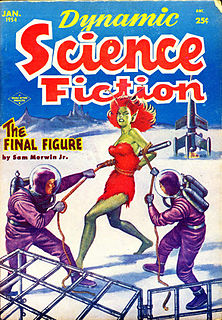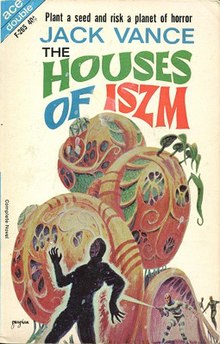
Dying Earth is a fantasy series by the American author Jack Vance, comprising four books originally published from 1950 to 1984. Some have been called picaresque. They vary from short story collections to a fix-up, perhaps all the way to novel.

Pulp magazines were inexpensive fiction magazines that were published from 1896 to the late 1950s. The term pulp derives from the cheap wood pulp paper on which the magazines were printed. In contrast, magazines printed on higher-quality paper were called "glossies" or "slicks". The typical pulp magazine had 128 pages; it was 7 inches (18 cm) wide by 10 inches (25 cm) high, and 0.5 inches (1.3 cm) thick, with ragged, untrimmed edges.

Murray Leinster was a nom de plume of William Fitzgerald Jenkins, an American writer of science fiction and alternate history literature. He wrote and published more than 1,500 short stories and articles, 14 movie scripts, and hundreds of radio scripts and television plays.

John Holbrook "Jack" Vance was an American mystery, fantasy, and science fiction writer. Though most of his work has been published under the name Jack Vance, he also wrote several mystery novels under different pen names.
The Galactic Empire series is a science fiction sequence of three of Isaac Asimov's earliest novels, and extended by one short story. They are connected by their early place in his published works and chronological placement within his overarching Foundation Universe, set around the rise of Asimov's Galactic Empire, between the Robot and Foundation series to which they were linked in Asimov's later novels.

The Languages of Pao is a science fiction novel by American writer Jack Vance, first published in 1958, in which the Sapir–Whorf hypothesis is a central theme. A shorter version was published in Satellite Science Fiction in late 1957. After the Avalon Books hardcover appeared the next year, it was reprinted in paperback by Ace Books in 1966 and reissued in 1968 and 1974. Additional hardcover and paperback reprints have followed, as well as British, French and Italian editions.
Planets in science fiction are fictional planets that appear in various media of the science fiction genre as story-settings or depicted locations.

Planet of Adventure is a series of four science fiction novels by Jack Vance, which relate the adventures of the scout Adam Reith, the sole survivor of an Earth ship investigating a signal from the distant planet Tschai.

Startling Stories was an American pulp science fiction magazine, published from 1939 to 1955 by publisher Ned Pines' Standard Magazines. It was initially edited by Mort Weisinger, who was also the editor of Thrilling Wonder Stories, Standard's other science fiction title. Startling ran a lead novel in every issue; the first was The Black Flame by Stanley G. Weinbaum. When Standard Magazines acquired Thrilling Wonder in 1936, it also gained the rights to stories published in that magazine's predecessor, Wonder Stories, and selections from this early material were reprinted in Startling as "Hall of Fame" stories. Under Weisinger the magazine focused on younger readers and, when Weisinger was replaced by Oscar J. Friend in 1941, the magazine became even more juvenile in focus, with clichéd cover art and letters answered by a "Sergeant Saturn". Friend was replaced by Sam Merwin Jr. in 1945, and Merwin was able to improve the quality of the fiction substantially, publishing Arthur C. Clarke's Against the Fall of Night, and several other well-received stories.

Interstellar Pig, published in 1984 by Bantam Books, is a science fiction novel for young adults written by William Sleator. It was listed as an ALA Notable Book, a SLJ Best Book of the Year, and a Junior Literary Guild Selection.

Big Planet is a science fiction novel by American writer Jack Vance. It is the first novel sharing the same setting, an immense, but metal-poor and backward world called Big Planet.

Samuel Kimball Merwin Jr. was an American mystery fiction writer, editor and science fiction author. His pseudonyms included Elizabeth Deare Bennett, Matt Lee, Jacques Jean Ferrat and Carter Sprague.

Terence William (Terry) Dowling, is an Australian writer and journalist. He writes primarily speculative fiction and dark fantasy though he considers himself an "imagier" – one who imagines, a term which liberates his writing from the constraints of specific genres. He has been called "among the best-loved local writers and most-awarded in and out of Australia, a writer who stubbornly hews his own path ."
A significant number of science fiction works have explored the imaginative possibilities of binary or multiple star systems. Many real stars near the Sun belong in this category.
Underwood–Miller Inc. was a science fiction and fantasy small press specialty publishing house in San Francisco, California, founded in 1976. It was founded by Tim Underwood, a San Francisco book and art dealer, and Chuck Miller, a Pennsylvania used book dealer, after the two had met at a convention.

The Five Gold Bands is a science fiction novel by American writer Jack Vance, first published in the November 1950 issue of Startling Stories magazine. It was published in 1953 as a separate book under the title The Space Pirate, and in 1963 it was paired with Vance's Hugo Award-winning novella The Dragon Masters in the form of an Ace Double.

Son of the Tree is a science fiction novella by American writer Jack Vance. It was first published in Thrilling Wonder Stories magazine, June 1951, and in book form as half of an Ace Double in 1964 together with The Houses of Iszm. The version that appears in the Ace Double is still less than novel length at about 31,000 words, but is essentially the same as the original magazine version. Son of the Tree was re-published as a stand-alone volume in 1974 by Mayflower.

Space Stories was a pulp magazine which published five issues from October 1952 to June 1953. It was published by Standard Magazines, and edited by Samuel Mines. Mines' editorial policy for Space Stories was to publish straightforward science fiction adventure stories. Among the better-known contributors were Jack Vance, Gordon R. Dickson and Leigh Brackett, whose novel The Big Jump appeared in the February 1953 issue.














